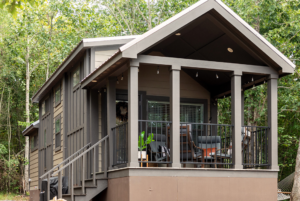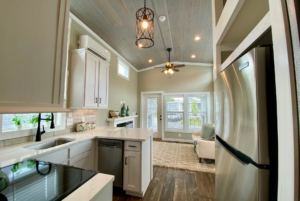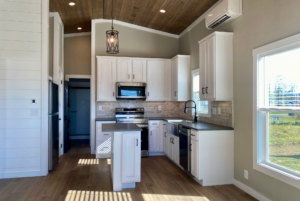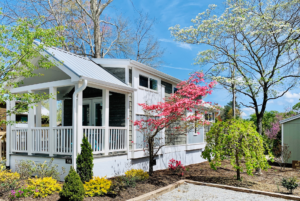You’ve probably been captivated by the allure of the tiny home lifestyle, haven’t you? It’s simple, sustainable, and can significantly cut living costs. But before you jump into this minimalist living trend, there are key factors you need to consider.
The legalities, space requirements, budgeting, and design possibilities are just a start. It may seem straightforward, but the reality of tiny living could be drastically different from your expectations.
So, are you ready to uncover what it truly takes to transition into a tiny home?
Understanding the Tiny House Movement
Before diving into the tiny home market, it’s crucial you grasp the nuances of the Tiny House Movement, a growing trend that champions a simpler, more sustainable lifestyle.
It’s not just about downsizing, but a conscious decision to minimize your carbon footprint and live debt-free.
This movement isn’t for everyone, so it’s vital you scrutinize your needs and adaptability. Can you comfortably live within 400 square feet or less? Are you ready to declutter and keep only what’s truly essential? It’s not just a home, it’s a lifestyle.
Embracing this movement means valuing experiences over possessions, and it can lead to increased freedom and happiness. Remember, understanding the philosophy behind the movement is the first step to making an informed decision.

Legalities and Zoning Issues
In navigating the path to owning a tiny home, you’ll need to confront the potential legalities and zoning issues that come with it. Laws vary by location, so what’s acceptable in one area might be illegal in another. Research local zoning laws and building codes to ensure you can legally build or park your tiny home.
You’ll also need to consider utilities like water, electricity, and sewage. Some areas have strict rules about these. Additionally, look into insurance. It can be tricky to insure a tiny home because they’re a relatively new concept.
If you’re planning on moving your tiny home, you’ll need to know the legal requirements for transporting it. These considerations may seem daunting, but they’re crucial in your tiny home journey.
Assessing Your Space Needs
Once you’ve tackled the legal complexities, it’s time to realistically assess your space needs in a tiny home.
This isn’t just about how many rooms you want; it’s about how you’ll use each inch of space. Consider your lifestyle. Do you work from home and need a dedicated office space? Are you a culinary enthusiast requiring a larger kitchen? Don’t forget storage – where will your belongings go?
Remember, in a tiny home, less is more. You might’ve to downsize possessions or opt for multi-functional furniture. Think about your future too. Will your tiny home accommodate changes in family size or mobility? Also, remember that outdoor space can be utilized efficiently.
Your space needs will greatly influence your tiny home decision.

Budgeting for a Tiny Home
After assessing your space needs, it’s crucial to crunch the numbers and figure out what you can afford when considering a tiny home.
Remember, buying a tiny home isn’t just about the upfront cost. You’ll need to budget for ongoing expenses like utilities, maintenance, and possibly a plot of land if you don’t already have one.
You also need to factor in the cost of downsizing, such as storage or selling excess belongings. Additionally, think about possible hidden costs like permits or zoning fees.
If you’re planning to move your tiny home frequently, don’t forget to budget for transportation costs.
Be realistic about your financial situation and carefully plan your budget before making the leap into tiny living.
Design and Customization Options
Having set a realistic budget for your tiny home, you’ll now want to explore the myriad of design and customization options available. Don’t be fooled into thinking small spaces limit creativity. In fact, tiny homes often require more innovative design solutions, making them a unique reflection of your personality.
You might decide on a loft-style bedroom for space efficiency, or a compact kitchen with all the essential amenities. Perhaps you’ll opt for built-in furniture or a convertible living area. Think about your lifestyle and needs. Do you work from home? You might need a dedicated workspace. Love cooking? Consider a larger kitchen area.

The Reality of Tiny Living
While the idea of tiny living may seem appealing, it’s crucial to consider the practical implications of such a lifestyle choice.
You’ll have less space, which means you’ll need to be creative and thoughtful about storage and organization.
You’ll also need to be comfortable with a pared-down style of living, as you won’t have room for many possessions or large pieces of furniture.
Tiny homes can also present challenges in terms of hosting guests or family, and can often feel cramped.
On the flip side, they can be more affordable and environmentally friendly.
It’s a lifestyle that requires significant adjustment, so make sure you’re ready for the reality of tiny living before you take the leap.
Future Resale Possibilities
In light of buying a tiny home, don’t overlook the importance of considering future resale possibilities. Keep in mind, the market for such homes is smaller than that of traditional houses. While you might love the idea of minimalist living, finding a buyer with similar tastes could be challenging when it’s time to sell.
Consider the location, too. A tiny home in a popular area might fetch a better price than one in a remote location. Also, quality and design play crucial roles in determining resale value. A well-built, aesthetically pleasing tiny home can command a higher price.

Conclusion
So, you’re ready to join the Tiny House Movement. Before diving in, make sure you’ve considered legalities, assessed your space needs, set a budget, and explored design options.
Understand the realities of tiny living and potential resale possibilities. Making an informed decision now will ensure your tiny home journey is a successful one. Remember, it’s not just about owning a smaller home but embracing a lifestyle of sustainability and minimalism.
Are you ready to take the plunge?





